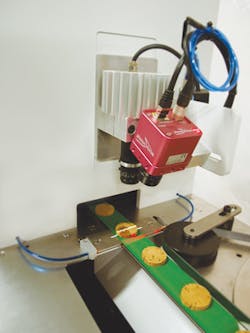Food and beverage: 3D imaging inspects cork disks at high-speed
Wine manufacturers must ensure that the cork stoppers used to seal their products are of the highest quality. However, because they are cut from the bark of an oak tree, some corks may have imperfections such as holes or color imperfections. While effects such as holes may not be acceptable, minor imperfections in the color of a cork may be deemed acceptable. To sort these, M3C Industrial Automation and Vision (Palafrugell, Spain; www.3control.net) has developed a line of automated systems that uses 3D imaging to inspect different types of cork stoppers and to inspect disks that are used to build cork stoppers. The system inspects these disks at up to 25,000 parts per hour.
To perform this task, the cork disks must first be oriented so that they can be imaged by the vision system. To do so, cork disks are first fed into a rotating bowl feeder where individual parts are then transferred along to a linear conveyor. "To singulate these disks," says Toni Tovar, Computer Vision Chief Technical Officer at M3C Industrial Automation and Vision, "they are first fed from the conveyor and onto a faster conveyor."
Once separated, they are imaged by a vision system where a 50μm white structured led light from Effilux (Les Ulis, France; www.effilux.fr) is used to illuminate the parts. Reflected light from the corks is then captured by a DR-1 double rate Gigabit Ethernet camera from Photonfocus (Lachen, Switzerland; www.photonfocus.com) that is triggered by each cork disk as it passes through a fiber-optic break-switch sensor.
Running at 1800fps, the system uses the region of interest (ROI) mode of the DR-1 camera to capture 125 images of each disk, each with a profile size of 896 x 100 pixels. These images are then transferred over the Gigabit Ethernet interface to a quad core Intel i5 processor running at 3.4GHz. Here, 3DExpress from Aqsense (Girona, Spain; www.aqsense.com) is used to generate a 2D representation of the cork disk containing 3D data.
"To analyze this color image," says Tovar, "the 3D representation must be processed to search defects such as unacceptably large holes as well as superficial deformations, incorrect sizes and color defects," To do so, custom software written in C++ is used to detect defects both within and at the exterior periphery of the disks. "Depending on the number and types of defects detected, the cork disks can then be classified as a maximum of six classes of good ones, ones that can be resized or ones that are bad," says Tovar.
While the first imaging station is used to produce a 3D profile of the top of the cork disk, the opposite side must also be inspected in the same manner. To accomplish this, the disks are then transported along the conveyor through a rotating drum-belt mechanism that turns each disk and deposits it in the reverse orientation onto a second conveyor belt. A video of the system in operation can be found at: www.bit.ly/1SOjXXS.
The re-oriented cork disks then pass through a second vision station that also uses an Effilux 50μm white structured led light to illuminate the parts and a Photonfocus DR-1 double rate Gigabit Ethernet camera to capture the reflected images. Once again, images are transferred over the camera's Gigabit Ethernet interface to the host PC for processing.
After analyzing both defects within and at the exterior periphery of the disks on both sides and classifying each one as good, acceptable or bad, the disks must be sorted into different bins. To do so, they move along the conveyor through a series of pneumatic sorter blowers that are actuated under control of a PLC that is interfaced to the host PC. Depending on how they have been classified, the PLC then triggers the blowers to separate the disks into different bins. Costing approximately €40,000, the system has been deployed in numerous cork manufacturing facilities throughout Europe.

